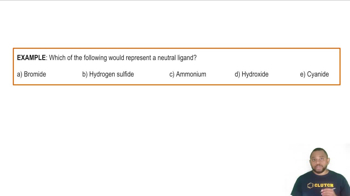Ch.23 - Transition Metals and Coordination Chemistry

Brown15th EditionChemistry: The Central ScienceISBN: 9780137542970Not the one you use?Change textbook
Chapter 23, Problem 31
Complete the exercises below. For each of the following pairs, identify the molecule or ion that is more likely to act as a ligand in a metal complex: a. acetonitrile (CH₃CN) or ammonium (NH₄⁺),
 Verified step by step guidance
Verified step by step guidance1
Step 1: Understand the concept of a ligand. A ligand is an ion or molecule that can donate a pair of electrons to a metal atom or ion to form a coordination complex. Ligands are typically Lewis bases.
Step 2: Analyze the electron pair availability in acetonitrile (CH₃CN). Acetonitrile has a nitrogen atom with a lone pair of electrons, making it capable of donating these electrons to a metal center.
Step 3: Analyze the electron pair availability in ammonium (NH₄⁺). Ammonium is a positively charged ion with no lone pairs of electrons available for donation, as all its electrons are involved in bonding.
Step 4: Compare the ability of each molecule or ion to act as a ligand. Since ligands need to donate electron pairs, the presence of lone pairs is crucial for this role.
Step 5: Conclude which molecule is more likely to act as a ligand. Based on the analysis, acetonitrile (CH₃CN) is more likely to act as a ligand than ammonium (NH₄⁺) due to the presence of a lone pair on the nitrogen atom.
Key Concepts
Here are the essential concepts you must grasp in order to answer the question correctly.
Ligands
Ligands are molecules or ions that can donate a pair of electrons to a metal ion to form a coordination complex. They can be classified as either monodentate, which bind through a single atom, or polydentate, which can attach through multiple atoms. The ability of a ligand to coordinate with a metal depends on its electron-donating ability and steric factors.
Recommended video:
Guided course

Ligands Example
Coordination Chemistry
Coordination chemistry studies the interactions between metal ions and ligands, focusing on the formation of coordination complexes. The properties of these complexes, such as stability and reactivity, are influenced by the nature of the metal, the type of ligands, and the geometry of the complex. Understanding these interactions is crucial for predicting the behavior of metal-ligand systems.
Recommended video:
Guided course

Coordination Numbers
Electronegativity and Charge
Electronegativity refers to the tendency of an atom to attract electrons in a bond. In the context of ligands, neutral molecules like acetonitrile (CH₃CN) can act as better ligands than positively charged species like ammonium (NH₄⁺) because they can donate electron pairs more readily. The charge and electronegativity of a ligand influence its ability to stabilize a metal center in a complex.
Recommended video:
Guided course

Electronegativity Trends
Related Practice
